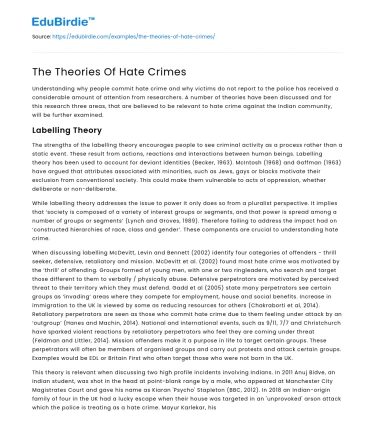Understanding why people commit hate crime and why victims do not report to the police has received a considerable amount of attention from researchers. A number of theories have been discussed and for this research three areas, that are believed to be relevant to hate crime against the Indian community, will be further examined.
Labelling Theory
The strengths of the labelling theory encourages people to see criminal activity as a process rather than a static event. These result from actions, reactions and interactions between human beings. Labelling theory has been used to account for deviant identities (Becker, 1963). McIntosh (1968) and Goffman (1963) have argued that attributes associated with minorities, such as Jews, gays or blacks motivate their exclusion from conventional society. This could make them vulnerable to acts of oppression, whether deliberate or non-deliberate.
Save your time!
We can take care of your essay
- Proper editing and formatting
- Free revision, title page, and bibliography
- Flexible prices and money-back guarantee
While labelling theory addresses the issue to power it only does so from a pluralist perspective. It implies that ‘society is composed of a variety of interest groups or segments, and that power is spread among a number of groups or segments’ (Lynch and Groves, 1989). Therefore failing to address the impact had on ‘constructed hierarchies of race, class and gender’. These components are crucial to understanding hate crime.
When discussing labelling McDevitt, Levin and Bennett (2002) identify four categories of offenders - thrill seeker, defensive, retaliatory and mission. McDevitt et al. (2002) found most hate crime was motivated by the ‘thrill’ of offending. Groups formed of young men, with one or two ringleaders, who search and target those different to them to verbally / physically abuse. Defensive perpetrators are motivated by perceived threat to their territory which they must defend. Gadd et al (2005) state many perpetrators see certain groups as ‘invading’ areas where they compete for employment, house and social benefits. Increase in immigration to the UK is viewed by some as reducing resources for others (Chakraborti et al, 2014). Retaliatory perpetrators are seen as those who commit hate crime due to them feeling under attack by an ‘outgroup’ (Hanes and Machin, 2014). National and international events, such as 9/11, 7/7 and Christchurch have sparked violent reactions by retaliatory perpetrators who feel they are coming under threat (Feldman and Littler, 2014). Mission offenders make it a purpose in life to target certain groups. These perpetrators will often be members of organised groups and carry out protests and attack certain groups. Examples would be EDL or Britain First who often target those who were not born in the UK.
This theory is relevant when discussing two high profile incidents involving Indians. In 2011 Anuj Bidve, an Indian student, was shot in the head at point-blank range by a male, who appeared at Manchester City Magistrates Court and gave his name as Kiaran 'Psycho' Stapleton (BBC, 2012). In 2018 an Indian-origin family of four in the UK had a lucky escape when their house was targeted in an 'unprovoked' arson attack which the police is treating as a hate crime. Mayur Karlekar, his wife Ritu and two young children were asleep in their home in London and were woken by a huge blaze outside their home. This blaze was believed to have started by youths who were carrying out this hennas act as a dare.
Subcultural theory
Subcultures are seen as values and norms different from the majority. These subcultures may include, Goths, hippies, bikers and even those who are fans of grime or heavy metal (What Is Subculture? - Theories, Definition & Examples, 2015). Becker (1963) goes on to explain that subcultures are labelled as outsiders by society and not only the result of alternate action strategies.
GMP were first to add a subculture as a category of hate crime (GMP, 2013). This allows for alternative communities, who are not part of the five nationally agreed hate crime categories, to confidentially report concerns to police. Sophie Lancaster and her boyfriend were attacked by a gang of youths in August 2007. The trial heard that the gang turned on the couple because they were goths or ‘moshers’ and dressed differently to them. Although there are 45 Police Forces within the UK only 11 have subculture as a monitored strand of hate crime (Gov.UK, 2020).
Subculture theory is relevant to the research as Indians fall with different categories based on their faiths and beliefs. Examples would be Sikhs who wear turbans or some who wear Bindi’s to identify themselves from a different faith to another fellow Indian. Both may be of Indian background but their subculture is different.
Othering
“Othering” refers to the process where individuals or groups of people ascribe negative characteristics to others (Rohleder, 2014). Othering is seen by some as not being about liking or disliking someone. They believe that certain identified groups pose threats to the majority but this negativity is driven by politicians and media opposed to them actually having contact with the group (Powell, 2017). Othering excludes people who are not part of the norm and means to exclude them from social groups for being the ‘other’. Examples include Nigel Farage who described migrants as an invasion and posed a threat to the UK. Although Indian communities were targeted this was not reflected on police reports.
The hypothesis for this research suggests that hate crime in recent years has increased dramatically. However, hate crime against the Indian community still remains underreported. It is believed that the Indian community has a poor relationship with the police and there are barriers to reporting hate crime. This could be language or lack of understanding on how to report an incident. There could also be a lack of understanding on what a hate crime is and victims have established abuse as the ‘norm’ and have heightened sensitivity to hate crime.






 Stuck on your essay?
Stuck on your essay?

